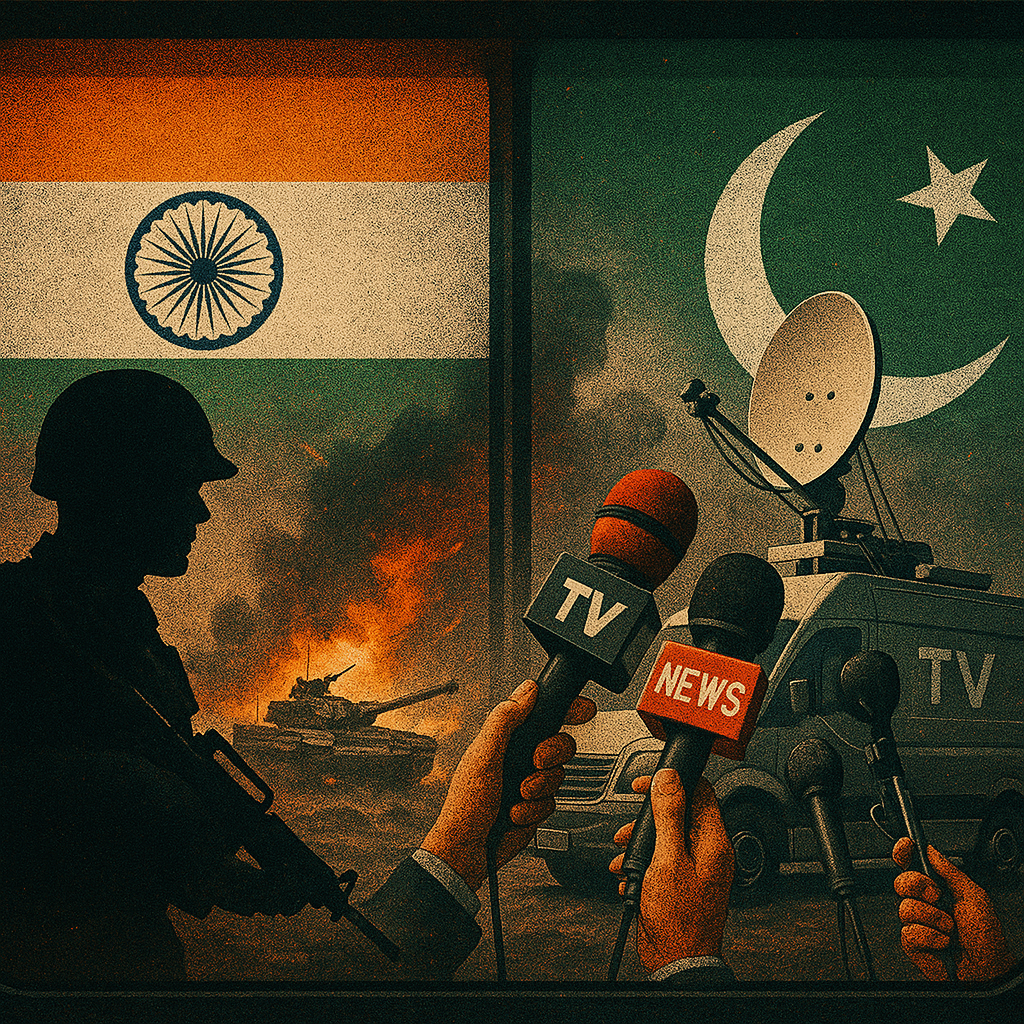
- Operation Sindoor was a military success for India, but was obscured diplomatically by Pakistan’s propaganda fog.
- In an era where perception shapes policy, such restraint without storytelling becomes indistinguishable from indifference or guilt.
- Despite having a just cause and surgical execution, India was once again outmanoeuvred in the information domain.
- In today’s world, if you don’t tell your story, someone else will, and you won’t like the version they write.
Introduction: The Strike That Sparked a Storm
On May 9, 2024, India executed Operation Sindoor, a swift and precise cross-border airstrike targeting terror infrastructure in Pakistan-occupied Kashmir (PoK). Launched in retaliation for the gruesome ambush in Poonch that claimed the lives of five Indian soldiers, the operation was an act of strategic deterrence. Militarily, India struck with precision and restraint. But as jets returned safely to base, a different kind of war was only just beginning, one that would unfold not on the ground, but in the virtual trenches of global perception. And in that war, Pakistan scored a decisive early lead.
Pakistan’s Narrative Blitzkrieg
Within hours of the strike, Pakistan unleashed a well-oiled information warfare machine. Videos of children crying, images of collapsed houses, and emotionally charged testimonials from “civilians” were broadcast on Pakistani news channels and pushed through thousands of bot and troll accounts online. Hashtags like #IndianAggression, #KashmirUnderAttack, and #StandWithKashmir began trending globally.
The Inter-Services Public Relations (ISPR), Pakistan’s military media wing, conducted multiple press briefings, portraying the strike as an unprovoked act of aggression against “civilians in a disputed territory.” Despite no verified civilian casualties, Pakistan’s narrative, crafted for emotion, not accuracy, resonated widely. Major international outlets picked up and reproduced the storyline with minimal fact-checking.
Analysis of the Articles Related to Operation Sindoor in Foreign Media
Objective: The purpose of this exercise is to evaluate the narrative that has emerged after the April 22 Pahalgam attack and subsequent Indian strikes on Pakistan’s terrorist targets.
Neutrality Rating Scale (1-9):
- 5 = Neutral
- 1–4 = Tilted towards Pakistan (with 1 being the most tilted, and 4 less so)
- 6–9 = Tilted towards India (with 6 being mildly tilted, and 9 being the most)
Note: Ratings are subjective and have been determined after analysing each article individually.
| S.No | Article | Date | Publication | Stance | Author | Neutrality Rate |
| 1. | India’s strike on Pakistan isn’t about terrorism: Kashmir (Opinion) | 08/05/2025 | Newsweek | Pro Pakistan | Imran Khalid – Columnist on TR (Pakistani) | 1 |
| 2. | Opinion: Kashmir Is the Fuse, but Hindutva Is the Fire | 08/05/2025 | E-International Relations | Pro Pakistan | Andrew Latham – Institute for Peace and Diplomacy | 3 |
| 3. | Does India still have an airpower advantage over Pakistan? | 08/05/2025 | The Spectator | Pro Pakistan | Fabian Hoffmann – Research fellow at the Oslo Nuclear Project at Oslo University. | 3 |
| 4. | India attacks Pakistan’s declaration of Israel-style expansionism | 09/05/2025 | Middle East Eye | Pro Pakistan | Azad Essa – Journalist, Middle East Eye | 1 |
| 5. | India tried to project strength but ended up showing weakness | India-Pakistan Tensions | Al Jazeera | 11/05/2025 | Al Jazeera | Pro Pakistan | Yousuf Nazar – former head of Citigroup’s emerging markets investments (Pakistani) | 2 |
| 6. | Pakistan comes out emboldened after clashes with India | 13/05/2025 | The Diplomat | Pro Pakistan | Umair Jamal – Correspondent for The Diplomat (Pakistani) | 1 |
| 7. | Lessons for the next India-Pakistan war | 14/05/2025 | Centre for Asia Policy Studies | Neutral | Joshua T. White – Foreign Policy, Centre for Asia Policy Studies | 5 |
| 8. | Operation Sindoor: A Decisive Victory in Modern Warfare | 14/05/2025 | X (@SpencerGuard) | Pro India | John Spencer (Chair of Urban Warfare Studies at Modern War Institute) | 9 |
| 9. | Chinese weapons pass combat test in India-Pakistan clash – with flying colours | 14/05/2025 | France 24 | Pro Pakistan | Leela Jacinto – Editor, France24 | 3 |
| 10. | Operation Sindoor and the Evolution of India’s Military Strategy Against Pakistan – War on the Rocks | 19/05/2025 | War on the Rocks | Pro India | Arzan Tarapore – Research scholar at the Centre for International Security and Cooperation | 8 |
| 11. | Calibrated Force: Operation Sindoor and the Future of Indian Deterrence | Royal United Services Institute | 21/05/2025 | Royal United Services Institute (RUSI) | Pro India | Dr. Walter Ladwig – Lecturer in International Relations, War Studies at KCL | 8 |
| 12. | Flawless Kill Chain: Pakistan’s Networked Strike Took Down Indian Fighter, Says U.S. Analyst – Defence Security Asia | 22/05/2025 | Defence Security Asia | Pro Pakistan | Defence Security Asia – based on an interview with Michael Dahm in Air & Space Forces Magazine | 2 |
| 13. | The Next War Between India and Pakistan | Foreign Affairs | 23/05/2025 | Foreign Affairs | Pro Pakistan | Aqil Shah – Professor of South Asian Politics, Oklahoma University (Pakistani) | 3 |
| 14. | Squabbling Siblings: India, Pakistan And Operation Sindoor – OpEd – Eurasia Review | 28/05/2025 | Eurasia Review | Pro Pakistan | Binoy Kampmark – Ex-Commonwealth Scholar at Selwyn College, Cambridge | 2 |
| 15. | Beyond The Haze Of War: Unpacking The Indo-Pak Air Superiority Claims – OpEd – Eurasia Review | 28/05/2025 | Eurasia Review | Pro Pakistan | Altaf Moti – Pakistani Scholar | 1 |
| 16. | Four Days in May: The India-Pakistan Crisis of 2025 • Stimson Centre | 28/05/2025 | Stimson Center | Neutral | Christopher Clary – Professor of political science at the University at Albany | 5 |
India’s Silence: Strategic or Self-Sabotaging?
In stark contrast, New Delhi remained largely silent. The Ministry of External Affairs issued a brief, non-descriptive statement nearly 12 hours later, confirming the operation and reiterating India’s right to self-defence. But there were no visuals, no detailed briefings, no attempt to frame the operation through India’s lens.
This silence was costly. In the vacuum, Pakistan’s propaganda thrived.
It wasn’t the first time India had exercised strategic restraint. But in an era where perception shapes policy, such restraint without storytelling becomes indistinguishable from indifference or guilt. India, despite having a just cause and surgical execution, was once again outmanoeuvred in the information domain.
The Echo Chamber of Western Media

Pakistan’s narrative was not just amplified, it was endorsed by segments of the Western press, who have long viewed Kashmir through a post-colonial, human-rights-focused lens. Outlets like Al Jazeera, TRT World, and The Middle East Eye ran sympathetic coverage based on Pakistani claims. Stories headlined “India bombs civilians in PoK” or “Escalation by New Delhi raises fears of war” emerged without critical scrutiny or independent verification.
This phenomenon isn’t new. The Pulwama-Balakot episode in 2019 and the Galwan Valley clash of 2020 showed similar trends: India being reactive, Pakistan being proactive, and the global media leaning on more vocal, accessible, and emotion-laden sources.
India’s failure is systemic. It lacks an institutionalised strategic communication framework capable of pre-empting, countering, or even co-authoring narratives in a rapidly moving news cycle.
Independent Analysts to the Rescue—Too Late
A few credible voices tried to restore balance, but their efforts came too late and reached too few.
- John Spencer, Chair of Urban Warfare Studies at the Modern War Institute, analysed satellite imagery and blast patterns, confirming the precision of India’s strike and lack of collateral damage.
- Michael Kugelman of the Wilson Centre contextualised the strike as a proportional response to terrorism.
- Christine Fair, a long-time critic of Pakistani military duplicity, took to X to expose the disinformation campaign launched by ISPR.
Yet these experts were not part of an orchestrated Indian effort. They were lone voices in a storm, and their fact-based insights couldn’t match the velocity or virality of emotionally charged propaganda.
Why India Keeps Losing the Narrative Battle
Despite its diplomatic heft and military professionalism, India keeps falling short in the war of narratives. Here’s why:
- No Rapid Response Communication Unit: Unlike Pakistan’s ISPR, India has no real-time strategic communication team embedded within its armed forces or foreign ministry.
- Lack of Global Media Penetration: India doesn’t invest enough in international media training, placement, or engagement. Pakistani officials and “experts” appear regularly on Western panels. Indian counterparts, rarely.
- Digital Passivity: While Pakistan has troll farms and bot networks, India’s digital diplomacy remains bureaucratic and slow. By the time an Indian clarification is issued, the global narrative has already ossified.
- Absence of Visual Proof: In an image-driven world, India provides no drone footage, precision maps, or interviews with officers. Truth, without packaging, rarely travels far.
Learning from Operation Sindoor: A Playbook for Future Messaging
To avoid losing the perception war again, India must treat information as a strategic weapon. Here’s what must change:
- Create a Centralised Strategic Communications Task Force: This should include military officials, digital experts, diplomats, and crisis PR professionals working in sync.
- Invest in Pre-bunking & Real-Time Narratives: Brief top global media houses with satellite images, intentions, and legal justifications before operations are launched. Get ahead of the narrative.
- Leverage the Indian Diaspora: Millions of articulate, patriotic Indians in media, law, and academia across the West can act as soft power multipliers, if mobilised.
- Partner with Think Tanks & Allies: Pre-seed your narrative with institutions like CSIS, Hudson Institute, RUSI, and others that influence global policymaking.
- Own the Emotional Space Too: Don’t just explain the strategy, tell the human story. Talk about the families of slain soldiers, the restraint shown in targeting only terror hubs, and the moral compass that guides Indian operations.
Conclusion: Winning the War Off the Battlefield
India has proven it can conduct precise, effective, and ethical military operations. But in the age of cognitive warfare, optics often override outcomes. Operation Sindoor succeeded militarily but was obscured diplomatically by Pakistan’s propaganda fog.
This must be a wake-up call. Future conflicts will not be judged merely by territorial gains or tactical wins but by whose story dominates the screens and feeds of the world.
If India wants to protect its global standing, deter future terror attacks, and uphold the moral legitimacy of its actions, it must win not just the war on the ground but also the one in the mind. Because in today’s world, if you don’t tell your story, someone else will—and you won’t like the version they write.
Diksha Bharti is currently pursuing a Master’s program in Russian studies. She has previously worked as a Research Associate at Politika and the Consilium Research Institute. She has a keen interest in geopolitics and has contributed to several reputed platforms. Views expressed are the author’s own.
